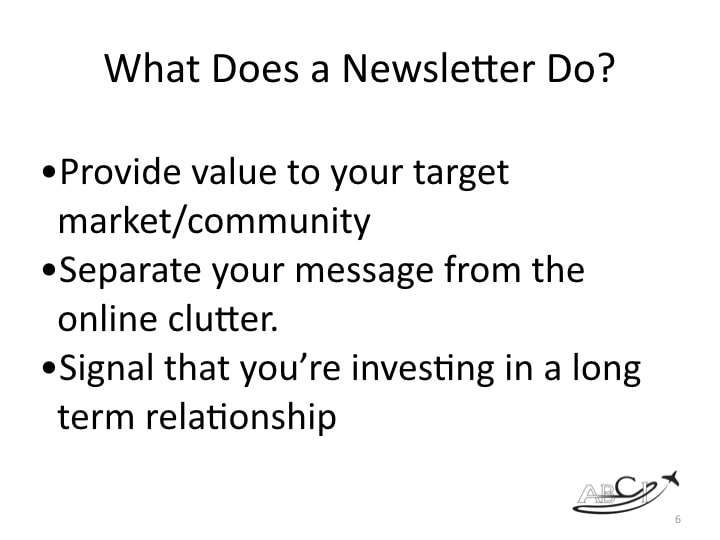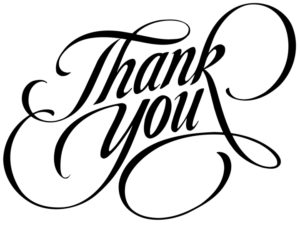Should your company produce a printed newsletter?
It’s expensive, it’s time consuming, and it’s a big hassle.
And it’s also one of the most effective marketing techniques for some aviation companies in certain circumstances!
[embedyt] https://www.youtube.com/watch?v=kyyWH8-i0-Q[/embedyt]
[smart_track_player url=”http://traffic.libsyn.com/aviationmarketing/Should_We_Produce_a_Printed_Newsletter_.mp3″ background=”default” ]
Transcript – Should We Produce a Printed Newsletter?
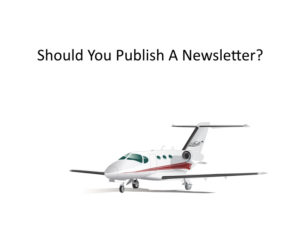 Paula Williams: Welcome to this week’s episode. I’m Paula Williams.
Paula Williams: Welcome to this week’s episode. I’m Paula Williams.
John Williams: I’m John Williams.
Paula Williams: And we are ABCI, and ABCI’s mission is…
John Williams: To help all you ladies and gentlemen out there sell more products and services in the aviation world.
Paula Williams: Right, exactly.
John Williams: Well, aviation products in general, wherever you sell them.
Paula Williams: That’s true. So this week’s episode is about should you publish a newsletter, and why and how, and some of those other related questions. Right?
John Williams: Okay.
This episode has been brought to you by our Aviation Sales and Marketing Lab
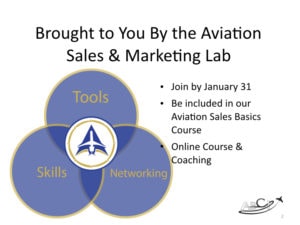 Paula Williams: Okay. So, this episode is brought to you by the Aviation Sales and Marketing Lab. If you join us by January 31st, then you will be included in our Aviation Sales Basics Course, which is a $499 value, yours free. Right?
Paula Williams: Okay. So, this episode is brought to you by the Aviation Sales and Marketing Lab. If you join us by January 31st, then you will be included in our Aviation Sales Basics Course, which is a $499 value, yours free. Right?
John Williams: Yours included.
Paula Williams: Yours included with your membership. And it’s actually a really good deal, because it is an online course and coaching that will really help you improve your sales skills, and sell a lot more in 2020 than you did in 2019, or any other time. Right?
John Williams: Yup, exactly.
Paula Williams: Okay. You cannot help but improve your sales skills if you follow this course.
John Williams: Are determined to learn.
Why produce a printed newsletter?
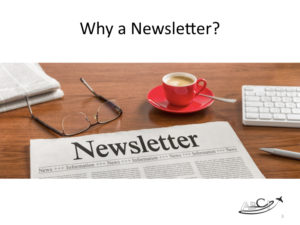 Paula Williams: Exactly. There you go. Okay, so why a newsletter?
Paula Williams: Exactly. There you go. Okay, so why a newsletter?
John Williams: That’s an interesting question. We did it for several years. I don’t remember why we stopped.
Paula Williams: Time mostly.
John Williams: But people called us and said, “I want a copy your newsletter, how do I get it?”
Paula Williams: Right. “You’ve stopped sending me your newsletter. What did I do wrong? How did we get on your naughty list or whatever, because we really look forward to your newsletter.” But it was mainly time. At the time our staffing was such that we just couldn’t put it together and make sure that it went out on a timely basis and everything else. We have come to reconsider that decision.
John Williams: And staffing has increased significantly since then, so I think we can probably do it.
Paula Williams: Exactly, And also some things have happened, like Rev, it’s one of those things that does transcripts and everything else that saves us a lot of money. At the time that we stopped doing our newsletter, we had to do a lot of work ourselves manually that can be automated or delegated-
John Williams: Oh, exactly.
Paula Williams: Because of technology. So some of that extra time we’re able to do some of the things and go back and say, “What was really working for us that we quit doing because we just didn’t have the time?”
John Williams: Mm-hmm (affirmative).
Prospects like printed newsletters.
Paula Williams: Okay. And the newsletters are one of those things. So prospects like newsletters, and there’s a lot of data that supports that. So six out of 10 US consumers surveyed say they enjoy getting postal mail from brands about new products. Believe it or not, they would rather do that than see an email or a voicemail or a webpage or a ad in their social media or any other thing.
John Williams: Me too.
Paula Williams: Okay. Absolutely. Across all key verticals from financial and insurance to retail and personal care, direct mail is preferred over email by all respondents. Crazy.
John Williams: Well, and again, who did this?
Paula Williams: I will tell you in a minute.
John Williams: Okay.
Paula Williams: I don’t remember. No, we’ll cut that part out. But anyway, the propensity for direct mail also extends to the 18 to 34-year-old demographic. So you think, well, that’s great for old people, but some of my clients are younger folks, they don’t like direct mail. Not true, right?
John Williams: Absolutely. I guess so.
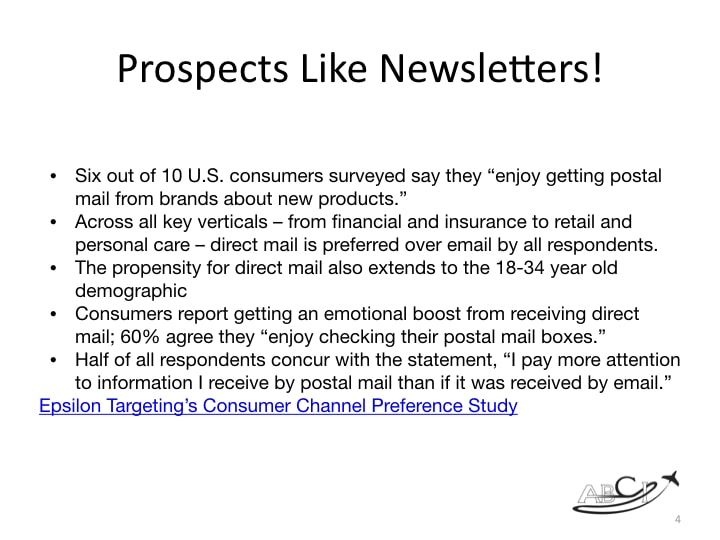 Paula Williams: Okay. Consumers report getting an emotional boost from receiving direct mail. 60% agree that they enjoy checking their postal mailboxes. We had our mail on hold while we were out of town recently, and we kept going to the mailbox after the mail hold was supposed to have ended, and we’re like, “What happened? We’re not getting any mail. Are we not important suddenly or what happened?” So it is a weird thing. Half of all respondents concur with the statement, “I pay more attention to information that I receive by postal mail and if it were received by email.”
Paula Williams: Okay. Consumers report getting an emotional boost from receiving direct mail. 60% agree that they enjoy checking their postal mailboxes. We had our mail on hold while we were out of town recently, and we kept going to the mailbox after the mail hold was supposed to have ended, and we’re like, “What happened? We’re not getting any mail. Are we not important suddenly or what happened?” So it is a weird thing. Half of all respondents concur with the statement, “I pay more attention to information that I receive by postal mail and if it were received by email.”
John Williams: There’s a thought.
Paula Williams: Is that true of you?
John Williams: With respect to sales?
We pay more attention to postal mail than email.
Paula Williams: Do you pay more attention to information, any information that you receive by postal mail than email?
John Williams: Probably mostly.
Paula Williams: Yeah, I think so too. Because even if it’s something from a bank, or something like that, I feel like if they send it by postal mail, they’re serious. If they send it by email, then it’s an optional thing or whatever.
John Williams: Yeah, but just like the insurance, the electric company’s trying to sell us, or the power company, whatever it was.
Paula Williams: If that were an email, I’d just delete it.
John Williams: Yeah. Exactly.
Paula Williams: But they sent us a postal letter, it’s an optional service offered by our public utilities commission or whatever.
John Williams: Right.
Paula Williams: But we read it, because it came in a postcard. So we’re like, “This must be important. We better read it.” Right?
John Williams: Suckered in again, huh?
Paula Williams: Exactly. If they had just sent us an email, I don’t think we would’ve spent five seconds on it.
John Williams: You know what? We’re not the only people that believe this. Everybody probably remembers getting emails from the Nigerian Prince with money to give away, right?
Paula Williams: Yeah. Oh yeah.
John Williams: Well, I got one in postal mail saying the same thing.
Paula Williams: It was pretty much the Nigerian Prince scam, but you got a letter saying that somebody had these unsecured funds from an other country that they only-
John Williams: They were talking about Africa, but they mailed it from France.
Paula Williams: Right. And they needed your bank account information in order to allow you to be the custodian for these funds or something.
John Williams: I mean it was a well thought out, and well formatted letter that made it look like business.
Paula Williams: Right. And you actually read part of it before you said, “You know what, this is the Nigerian Prince scam.”
John Williams: But they suckered me into read the first paragraph. I thought, “Well,”-
Paula Williams: Because it was on paper.
John Williams: Yeah.
Paula Williams: Okay. So the source of all this is Epsilon’s Targeting Consumer Channels study from 2019 I believe. So fairly recent, and pretty incredible information, and it does line up with what we know, I think from our customers and from our own experience.
John Williams: Right.
Will a printed newsletter work for an aviation company?
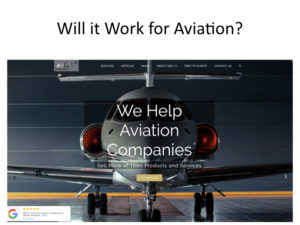 Paula Williams: Okay. So will it work for aviation, a postal newsletter?
Paula Williams: Okay. So will it work for aviation, a postal newsletter?
John Williams: Well, from personal experience, I bought my first airplane because of sales mail.
Paula Williams: A postcard.
John Williams: Postcard.
Paula Williams: Right.
John Williams: I took a… I didn’t do it on the first one, I think there were five or six. And you know, I mean you get the postcard and say, “Yeah, I’m going to do that.” And you throw it away, and forget about it. And you get the next one, and it said, “Oh yeah, I need to do that.” The airplane wasn’t a business function at the time. It was a personal thing. So there was no hurry. And then I actually kept that one but it got lost somewhere.
Paula Williams: I think you even carried it around in your shirt pocket for a little while, intending to make a call or look into it.
John Williams: Anyway, life happens, as you know. And it took three or four, maybe five before I made the phone call. Because I remember the last time I got the card, I said, “Damn it.” And I just sat there and I called them.
Paula Williams: Yeah. Right then when you got the card.
John Williams: Yep.
Paula Williams: And I’ve done that too with things that I get in the mail, they go into my pile.
John Williams: Yes. About that.
Paula Williams: Of things that I need to do. I get through the pile, on a more regular basis than I would getting back to an email or getting back to a social media post that I never would find again if I decided I don’t have time for this now, but I’m going to do it later. So it goes in my do it later physical pile, but it does.
John Williams: Which makes it a part of any campaign.
Paula Williams: Exactly.
John Williams: And that’s why we do it that way.
What does a printed newsletter do?
Paula Williams: Right. That is absolutely true. So what does a printed newsletter do? Number one, it provides value to your target market or your community, and that means that you have to put something into your newsletter that is actually useful. So a calendar of events, or a procedure, or a tool or a tip, something along those lines.
John Williams: Or even trivia that’s aviation-related that almost nobody knows about.
It separates your message from the online clutter.
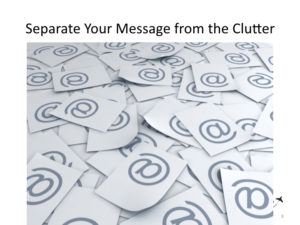 Paula Williams: Right. Something that is useful that they will look forward to getting from you each month or each quarter or whatever. A newsletter also separates your message from the online clutter. And it puts it into the physical clutter, but there’s less physical clutter than there is online clutter, right?
Paula Williams: Right. Something that is useful that they will look forward to getting from you each month or each quarter or whatever. A newsletter also separates your message from the online clutter. And it puts it into the physical clutter, but there’s less physical clutter than there is online clutter, right?
John Williams: Yep.
Paula Williams: Okay. It also signals that you’re investing in a longterm relationship. So this is not a fly by night thing. You are actually investing in paper and ink, and you’re putting a stamp on it, and you really are interested in this person getting your information. This was not a computer glitch. This was not a random thing.
John Williams: Yeah. And there’s ways to make it even better, rather than giving it to some printer and have him run it off automatically stamping and automatically putting email addresses on it and sending them out. I mean, there’s a better way to do that, but even that is better than nothing.
Paula Williams: Right. And it’s certainly better than an electronic means. And it’s a really nice mix where you can do your immediate, or your short-term posting. So if you have an empty leg or something like that that you need to post immediately, there’s no way to do that in a timely way other than electronic. But there’s some information that’s kind of evergreen that will wait for a month or a quarter, and you can put it into a newsletter.
John Williams: And not that we’ve done everything, but we’ve done a lot of experimentation over the last 13 years, and figured out mostly what’s got a better chance of working than what doesn’t.
It can provide valuable tips and information that people look forward to receiving each month.
 Paula Williams: Exactly. So the first thing you need to do as you are thinking about doing a newsletter is think of a way that you can provide value. So if you’re in insurance, you want to put some kind of a tip of the week, tip of the month, tip of the quarter, whatever it is, how people can save money, or get better value or do something with their insurance, or maybe top 10 mistakes that people make about your product or service, top 10 mistakes that new owners of Mooney aircraft make. Something along those lines that is really going to add value.
Paula Williams: Exactly. So the first thing you need to do as you are thinking about doing a newsletter is think of a way that you can provide value. So if you’re in insurance, you want to put some kind of a tip of the week, tip of the month, tip of the quarter, whatever it is, how people can save money, or get better value or do something with their insurance, or maybe top 10 mistakes that people make about your product or service, top 10 mistakes that new owners of Mooney aircraft make. Something along those lines that is really going to add value.
John Williams: Or in this day and age, is Mooney really still around and making airplanes?
Paula Williams: Right?
John Williams: Are they going to stick around? If you can get the inside track, then there you go.
Paula Williams: Some kind of insider information or a tool or something useful that they can actually pick up and use in their next conversation.
Or even around the airport, say, “Did you know that… ” There’s your trivia, right? So that’s something that’s useful because then they have something to say around the water cooler. Okay. So you solve a problem for them, or give them something for free, that they can use based on the fact that they’re getting this newsletter. It separates your message from the clutter as we talked about.
It goes into the physical pile rather than the electronic pile. A lot of times I will have a piece of mail from a supplier that is on my desk for whatever reason, or I will keep it because it has a coupon or something like that. Even if I don’t intend to use that coupon, I want to have their contact information handy. And so having that newsletter or that postcard handy will help me find them quickly next time I need something.
John Williams: And some of our vendors, we… it’s not weekly, monthly, even quarterly. It’s when we run out of product. I mean, they’re supplies, so then, “Oh, what do you mean you don’t have that? How do I get ahold of these guys?”
Paula Williams: Right. And who did we buy those from again? Because it’s something that we don’t buy every day.
John Williams: Right.
Paula Williams: But if we’re getting a quarterly newsletter from our printer, then we know, “Oh yeah, that’s the printer that we use for these items.” And we can find their contact information more easily and they stay top of mind for us. Because there’s a million printers on the web. But if we want to go with somebody that we know, like, and trust that we’ve used before, getting a newsletter is a really good-
John Williams: And they have a quality product, you don’t want to experiment with somebody else unless you absolutely have to.
It signals that you’re investing in a long-term relationship
 Paula Williams: Absolutely. So we want to send newsletters to our old customers, or even our current customers just to keep us top of mind. This is why you’re paying our bills, this is why we’re worth it to you. It also signals that you’re investing in a longterm relationship. So this is a really long road through, I think this is New Mexico, if you’re looking at our screen.
Paula Williams: Absolutely. So we want to send newsletters to our old customers, or even our current customers just to keep us top of mind. This is why you’re paying our bills, this is why we’re worth it to you. It also signals that you’re investing in a longterm relationship. So this is a really long road through, I think this is New Mexico, if you’re looking at our screen.
John Williams: Or Arizona. I don’t remember where it is, but we… I don’t know if we took that picture, but we’ve been on that road.
Paula Williams: Right, exactly. You see a long road ahead of you, and if you want to invest in a longterm relationship with another company, you really want to make sure that you are doing the foundational things, maintaining your relationship. And the way that relationships are maintained is by exchanging things, and information.
And contacting people often. So if you don’t hear from somebody for six months or a year, then that’s one of those holiday relatives or whatever that you only see once a year. But your best friend, you talk to them every day, or every week or every month or every quarter at least.
And that’s how you keep that relationship going. A lot of times we’ll get responses from our newsletter. Where someone is saying, “I just got your newsletter, I’ve been meaning to talk to you about X, Y, or Z. And it just reminded me of our relationship. It reminded me that you’re our guy or girl for this product or service.”
John Williams: Yep.
Who gets newsletters, and why?
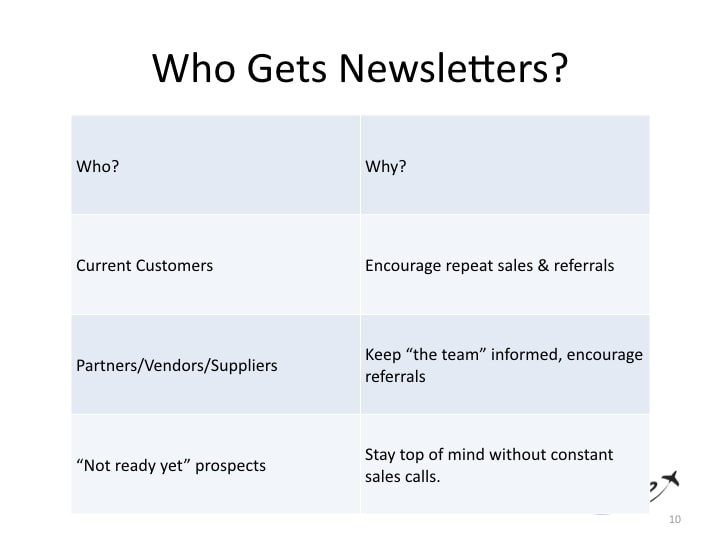 Paula Williams: Okay, so who gets newsletters? Who should we send them to? We send them to current customers, because we want to encourage repeat sales and referrals. Once again, we want them to remember that we are their marketing company, we’re their preferred vendor for that product or service. We send them to partners, vendors and suppliers because we want to keep the team informed, encourage referrals, and make sure that everybody is up on here’s what we’re into nowadays and here’s what’s going on with us. Here are some new products that we’re offering. Things like that. Because they may not know.
Paula Williams: Okay, so who gets newsletters? Who should we send them to? We send them to current customers, because we want to encourage repeat sales and referrals. Once again, we want them to remember that we are their marketing company, we’re their preferred vendor for that product or service. We send them to partners, vendors and suppliers because we want to keep the team informed, encourage referrals, and make sure that everybody is up on here’s what we’re into nowadays and here’s what’s going on with us. Here are some new products that we’re offering. Things like that. Because they may not know.
John Williams: Or they have forgotten.
Paula Williams: Exactly. And some of our suppliers are our best refers.
John Williams: Sometimes.
A printed newsletter is a great “holding pattern”activity for prospects who are not ready to buy yet
Paula Williams: Okay. And then the other one is, our not ready yet prospects. So we talked about every time we do a sales presentation, there are one of three responses. Yes, no, and not yet.
 John Williams: And if they’re not yets, they get a newsletter.
John Williams: And if they’re not yets, they get a newsletter.
Paula Williams: Right. In fact-
John Williams: As well.
Paula Williams: The majority of the sales presentations that we do, for whatever reason, the answer is not ready yet. And that is because the aviation industry is very complicated, has a long sale cycle. People have to get buy-in from their department or their whomever.
John Williams: And a lot of folks don’t realize, believe it or not, the customer’s acquisition costs money.
Paula Williams: Right. So this is an investment you have to be prepared to make and we unfortunately got out of it because of time, and we almost didn’t get back into it because of money. You look at this compared to some of the other forms of advertising that we do, it is one of the more expensive forms of advertising, but it is also one of the most effective as well. So that is why you are seeing a quarterly newsletter from us.
John Williams: Or will.
Paula Williams: Or will, which you may not have received yet, but hopefully have. If you’re not on our list, then get on our list by requesting one of our tip sheets or something along those lines and we’ll make sure that you get our newsletter.
John Williams: And that also means, because their snail mail address is optional.
Paula Williams: Mm-hmm (affirmative).
John Williams: If you want the thing, you need to put a valid snail mail address in.
We send ours only in the United States – that’s where most of our market is, and mail is cheap and reliable here.
Paula Williams: Absolutely. And we’re only sending it in the US only for the time being, so you can put those parameters on it. We think US only makes sense for us because most of our customers are in the United States, and also sending mail in some areas of the world is just not an affordable proposition, to be honest.
John Williams: And even if it is, you’re not sure it’s getting through.
Paula Williams: The return on investment just isn’t there. We’ve actually had mail come back from Singapore eight months later. So we sent it in January, we got it back in August, mangled to pieces.
John Williams: Yeah.
Paula Williams: And it looked like it had gotten wet, we just have no idea what happened to it between then and now. But it wasn’t good, whatever it is.
John Williams: We could go on for a long time, but just surely, we visited Pakistan, and while there-
Paula Williams: That was enlightening.
John Williams: We were given a tour of the post office in Lahore.
Paula Williams: Mm-hmm (affirmative).
John Williams: Oh boy. And you can see why mistakes are made, and why things don’t happen. It’s crazy. If you want to elaborate, go ahead. Because you could get stuck talking about this for a while.
Paula Williams: Right. But just to be really short about it, there are a dozen lines for a dozen different things, for buying a stamp, or getting it-
John Williams: There were 52 windows.
Paula Williams: Yeah. You didn’t necessarily need to do all 52 windows, but you needed to do at least 12 to mail a simple letter.
John Williams: Yeah, we just went there to mail a letter, but to do that, you had to first go and present the thing, and the guy said, “Yeah, that’ll work here.” And then you go to the next window.
Paula Williams: And you get a stamp on a piece of paper, and then you have to take the stamped piece of paper to the next guy.
John Williams: Yep. And so forth. And I don’t know if we went to 10 or 11 or 12 windows, took us probably two hours before we got out of there, and we weren’t really sure it was going to get where it was going. But it did.
Paula Williams: Yeah, it did. So it worked. But it was just incredibly bureaucratic. We actually are very, very fortunate in the United States to have the mail system that we do. So thank you Benjamin Franklin, and the Pony Express and all of the things that have gone into making the mail system what it is today, because we have really, really cheap and reliable mail, and to us marketers, that is a fantastic blessing. Not everybody has that.
John Williams: No they don’t.
Paula Williams: So we’re very fortunate, and I get that. Okay, so a newsletter should be part of your holding pattern for those not ready yet. So if someone has said, “We’ll talk about this when our new budget comes through”, or, “After I get my boss on board”, or whatever happens, we’re waiting for this to happen or that to happen, our not ready yets. You don’t want them to forget about you in the meantime and go off and do business with your competitor, because they will.
John Williams: Besides, they’ll have a newsletter sitting on their desk to remind them.
Paula Williams: Exactly. So what you want to do with those not ready yets is send them a book. You want to connect with them on social media. You want to see them when you go to NBAA, or any of those events. You want to call them on the phone every once in a while and just say, “How are things doing?” And, “We’re having a breakfast, and come meet our other clients.” Or whatever you could say to keep that relationship going. And you want to send them a newsletter, because that’s a really good way to keep that relationship going. Right?
John Williams: Right.
How often should you send a printed newsletter?
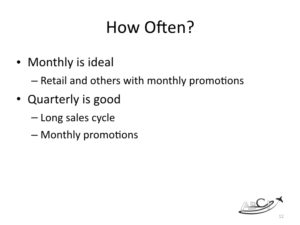 Paula Williams: Okay, cool. So how often do we send a newsletter?
Paula Williams: Okay, cool. So how often do we send a newsletter?
John Williams: About every third day.
Paula Williams: That’d be good. Okay. Monthly is ideal. A lot of the retail and other organizations, we’re part of a lot of different mastermind groups in marketing and other types of things where they talk about industry best practices and things like that. In retail, or carpet cleaning, or dentistry, or any other thing like that, then monthly really is the best deal, because people are always needing your product or service. So a lot of folks that have monthly promotions or other kinds of things, monthly is great. And if you can do monthly, that’s fantastic.
John Williams: Pricey though.
Paula Williams: It is pricey. Quarterly is good, and for us, quarterly makes the most sense because once again it comes down to our time. If we’re going to produce a quality newsletter, we want to make sure that we are doing it less frequently, but with more quality, and better information, being on time, all of those things. It’s really more important for us to be quarterly and be better, than to do a monthly one. And maybe not be quite so… not catch every typo and things like that. Of course, we’re not guaranteeing that we’re going to catch every type of anyway.
John Williams: Exactly.
Paula Williams: But we’re more likely to. So we have a longer sales cycle than most of those carpet cleaners, dentists, and retail folks. So doing monthly promotions is not really in our purview. We do quarterly promotions, and so a quarterly newsletter makes sense, right?
John Williams: Fits right in, yeah.
Join our Sales & Marketing Lab!
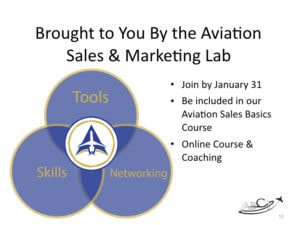 Paula Williams: Yeah, exactly. So that makes sense for us. All right, so this episode, hopefully we’ve convinced you that you need a newsletter, and we can help you put one together. If you are part of our Aviation Sales and Marketing Lab, we meet with you once a month and work on whatever it is that is on your mind.
Paula Williams: Yeah, exactly. So that makes sense for us. All right, so this episode, hopefully we’ve convinced you that you need a newsletter, and we can help you put one together. If you are part of our Aviation Sales and Marketing Lab, we meet with you once a month and work on whatever it is that is on your mind.
John Williams: Once a month.
Paula Williams: Once a month if you are in our VIP Sales and Marketing Lab, we have a pro version now that we meet with you quarterly, and that’s $179 a month. So you can go to our Aviation Sales and Marketing lab page and see what the differences are between those two memberships. The marketing lab is for companies, really, even small companies that are in the aviation industry that need the tools, the skills, the networking, all of those things to improve their sales. If you are a individual broker or insurance agent or an individual who works for an aviation company whose job is sales or marketing then you might want to look at our pro membership that is a little bit more affordable, but doesn’t have quite so many goodies.
John Williams: Right.
Paula Williams: Okay. If you join us before January 31st, then you will be included in our Aviation Sales Basics course, which is a whole lot of fun. And it is the best possible way to learn sales or marketing for the aviation industry, because it’s the only course that I know of that is really built for people who are doing this kind of thing every day.
John Williams: Right. And we’ve been through many sales courses.
Paula Williams: Yeah. Between the two of us, we’ve done Sandler and Pacific Institute and Dale Carnegie and a lot of these different sales programs. Franklin Covey.
John Williams: And real estate sales and life insurance sales, been to all those training programs. So we have a fairly good clue about what the rest of the country’s doing.
Paula Williams: Exactly. And we’ve taken the things that we reapply the best to aviation and put them together into this 12 week course that is really focused, and doesn’t waste your time on things that are not going to be relevant to the aviation industry.
John Williams: Exactly.
Paula Williams: All right. It’s an online course and coaching program, and we think you will really enjoy it. Of course, everything that we sell is satisfaction guaranteed. So if it doesn’t work for you, you get your money back. But everybody that I know that has gone through this course is a much better salesperson than they were going in.
John Williams: And they’re happy with it. Give us good reviews.
Paula Williams: Yeah. Right, exactly. You’re better at even selling things to your kids. Go to bed on time, or get off the Nintendo and those kinds of things, and get your room cleaned. You can sell anything to anybody, and it actually does improve your life a whole lot, if you are a better salesperson.
John Williams: True.
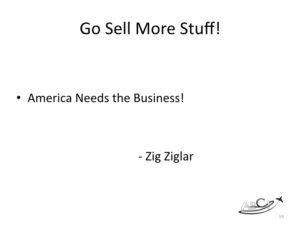 Paula Williams: Yeah. All right, so go sell more stuff.
Paula Williams: Yeah. All right, so go sell more stuff.
John Williams: America needs the business, [inaudible 00:24:56].
Paula Williams: absolutely. Thanks for joining us and we’ll see you next week.
John Williams: See you next time.
Podcast: Play in new window | Download
Subscribe: Spotify | Amazon Music | RSS

